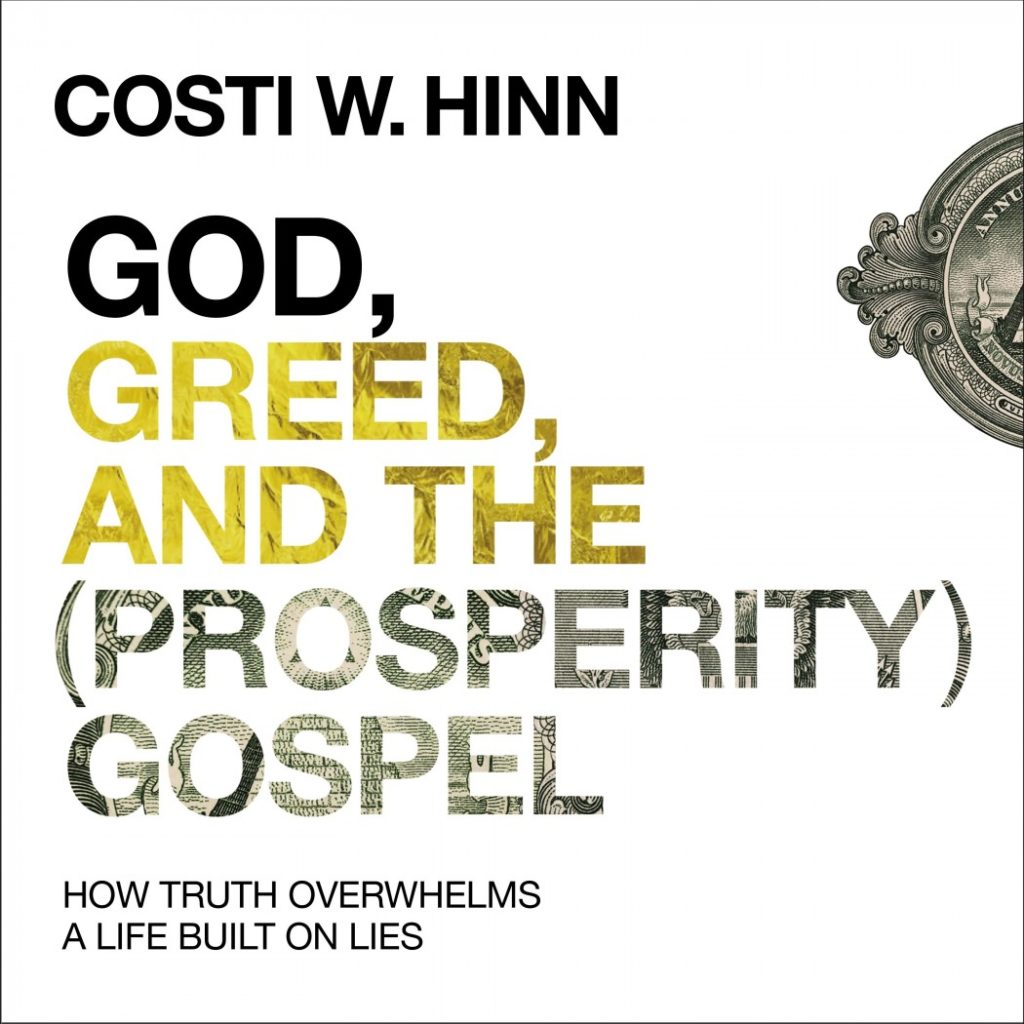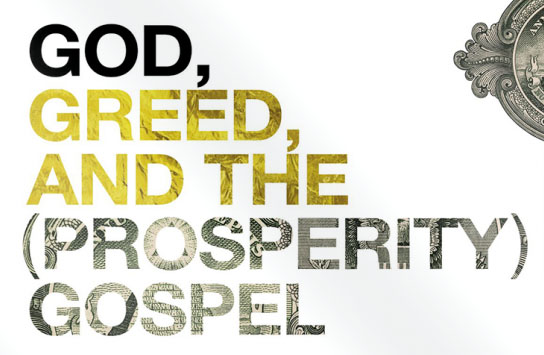
Costi Hinn. God, Greed, and the (Prosperity) Gospel. Grand Rapids, MI, USA: Zondervan, 2019, 223 pp.
Introduction
“The prosperity gospel is a disease” (178)
Costi Hinn ends a chapter entitled “A Dangerously Abusive Theology” in his 2019 autobiographical salvo against the Prosperity Gospel with that statement. Throughout this book, Hinn weaves together stories, theology, biblical exposition, and exhortation. In doing so, Hinn answers the question, “So why did you walk away from that life?” (18)
Zondervan published Hinn’s book, and they released it in 2019. It comes with endorsements from a number of evangelical pastors, leaders, and scholars — from Steven Lawson to Conrad Mbewe.
The book contains eleven chapters along with a preface and two appendices. Below is a brief summary of each chapter.
Summary
The preface answers the question “why.” Why did Hinn feel compelled to write the book. Hinn also addresses this question in an FAQ in Appendix 1. In sum, Hinn wants to address the “gospel injustice” that Prosperity Gospel (PG) teaching brings (18).
Chapter One
Chapter one is a brief biography of the Hinn family. Hinn traces their roots to a mix of Middle Eastern culture and Greek Orthodox religion. He comments that the language of his grandfather’s home was Arabic. He also mentions that while being “staunchly” Greek Orthodox, the religion played more of cultural role than a spiritual one. His family emigrated to North America (Toronto, Canada) in 1968. Hinn’s father’s and uncle’s classmates often bullied them because of their lack of English language skills. The Hnn family adopted the teachings of Kathryn Kuhlman whose mantra, “Don’t grieve the Holy Spirit.” (27). Hinn’s uncle, Benny Hinn, began a teaching and healing ministry. He modeled his ministry on the ministries of Kuhlman, Oral Roberts, and other prosperity teachers (29).
Chapter Two
Chapter two addresses the topic of bullying in Hinn’s pre-teen and teenage years. At times, other students bullied Hinn. At other times, Hinn bullied others. Hinn concludes the chapter with a story of a time when the family of the boy whom he assaulted with a skateboard Hinn loved and embraced him. Hinn recalls how, as a teenager, this love and grace is the face of rage and anger shocked and surprised him (44).
Chapter Three
In chapter three, Hinn recounts his attempts to try to make sense out of life (and death) according to the so-called “laws of prosperity.” When one of his uncles dies of cancer, Hinn’s only conclusion is that the uncle (or one of family members) must have been guilty of committing one of the “Big Four” (49). The “Big Four” is a list of actions that one must have committed if you are not healed. They include “making a negative confession,” “hanging around negative people,” “not having enough faith,” and “touching the Lord’s anointed.” These “sinful” actions will show up in other parts of Hinn’s story as he wrestles with the “gospel” that he was presented as a child with the biblical gospel that he came to discover.
Chapter Four
In chapter four, Hinn recalls his life of luxury during his time as a staff member with his uncle’s ministry. After vividly describing the lavish lifestyle that he enjoyed, Hinn comments that “we weren’t preaching the same gospel as Paul” (66). Hinn also recalls how he was beginning to see that the lifestyle that he enjoyed was “fueled by taking advantage of others” (59). These others were often “desperate people who believed that giving a prosperity preacher their money would result in their living this lifestyle too” (59).
Chapter Five
In chapter five, Hinn tells how the system and world of the Prosperity Gospel begins to unravel. This unraveling happens as he began to ask questions that did not have satisfactory answers. Hinn realized that most people (especially the poorest of the poor) were leaving his uncle’s services unhealed and even poorer than when they began (75). During this time period, Hinn begins to realize that “God does not take kindly to leaders going around lying to people in his name” (80).
Chapter Six
In chapter six, the truth of the gospel confronts his worldview. Hinn tells how he first heard the gospel taught and lived out at Dallas Baptist University (DBU). In an experience that can only be described as providential, DBU offered Hinn a baseball scholarship. While his family warned him about the impact that Baptists might have on his belief system, Hinn assured his father that he “would not become some stuffy Baptist” (84).
Both his baseball coach Dan Heefner and his professor Dr. Mike Milburn taught and lived out the gospel in front of Hinn. One of my favorite lines from this chapter is, “Baptists hate the prosperity gospel” (85). Hinn goes on to quote Mbewe, Al Mohler, and Russ Moore to support this idea. As a life-long Southern Baptist, I heartily agreed with Hinn’s assessment! Hinn closes this chapter with the ominous statement that “all roads that the prosperity gospel paves lead to hell” (100).
Chapter Seven
In the seventh chapter, Hinn begins to see the gaping holes in PG thought. Hinn’s fiancé (now wife) Christyne is introduced in this chapter, and she plays a vital role in this process. Hinn recalls four events that took place between 2011-2012 that “deepened our convictions about the prosperity gospel circles we ran in” (116). The first three events were orchestrated by the Hinn family to try and convince Christyne of the truth of PG teaching but backfired on them and showed Hinn the truth. The fourth was a time when Christyne nearly died of an asthma attack because she was hiding her treatment medication from the Hinn family. By the end of the chapter, Hinn recalls how at that point in his life he is convinced that he must either follow the ideas and philosophies that he has been taught his whole life, or he must follow biblical teaching.
Chapter Eight
In the eighth chapter, Hinn escapes his life in the Prosperity Gospel. As he recounts the story of how that happened, two big theological ideas stand out. First, God is sovereign over all things. PG teaching asserts that we can manipulate God and force him to act on our behalf. Hinn confronts this false teaching with the clear biblical teaching that God is in control of all things and is “not some cosmic genie who exists to give me what I want and do what I command him to do” (141).
The second big theological idea is God’s glory. Hinn came to understand that “God’s highest purpose was not to make me happy, healthy, and wealthy; it was to give him glory” (141). Hinn also began to find new theological heroes. He began to read books by and about people like William Tyndall, Hudson Taylor, Charles Spurgeon, and others. Hinn began his theological study at Talbot School of Theology and then transferred to Midwestern Baptist Theological Seminary.
Chapter Nine
In chapter nine, Hinn presents the truth that PG theology and thought is dangerous and destructive. Hinn gives the reader a very brief history of how PG developed. He also tries to explain why PG preaching is so appealing to people. He writes that, “the prosperity gospel appeals to the deep longing of every human heart for peace, health, wealth, and happiness” (155). Hinn also mentions in this chapter how PG preachers exploits places like South America and Africa and seeks to exploit some of the poorest people in the world.
After that, he lists four truths about the PG preachers and ten truths about PG thought. Hinn shows that false teachers are disguised as good guys (164), use deception to get rich (166), are in demand (167), and will get what they deserve (168). As for the ten truths of PG thought, Hinn writes that the prosperity gospel distorts the gospel (170), insults God’s nature (172), confuses the atonement (173), demeans Jesus Christ (174), twists Scripture (174), is motivated by love for money (175), produces false converts (175), overcomplicates the faith (176), ruins Christianity’s witness (177), and abuses vulnerable people (177).
Chapter Ten
In chapter ten, as the title of the chapter indicates, Hinn presents “a balanced view of health and wealth” (179). PG is dangerous because it mixes gospel truth with heretical falsehood. Hinn presents five principles for health and five principles for wealth. As for health, Hinn insists that “God still heals today” (181). He also writes that “Heath isn’t guaranteed on earth” and that “Christian joy is not dependent on circumstances” (182). The fourth principle for health is “suffering and trials are a part of life” (183). The final principle for health is that “physical limitations do not limit ministry impact” (184).
When discussing biblical principles on wealth, Hinn writes that “God owns everything” (185). Second, as with health, “Wealth isn’t guaranteed on earth” (186). Third, “Wealth is a tool for gospel advancement” (187). Fourth, “Wealth is not a sign of elite spiritual status” (188). Finally, “Wealth is an immense responsibility” (190).
Chapter Eleven
In the final chapter, Hinn exhorts us as readers to reach out to people who are trapped in the Prosperity Gospel. From Jude 22-23, Hinn lists three categories of people who are caught in deception: “the doubters” (196), “the deceived” (196), and “the dangerous” (197). After describing each of these categories, Hinn gives the reader ten steps “for reaching people who are caught in dangerous belief systems” (198). First, “pray for them” (201). Second, “study the truth” (202). Third, “deal with your heart issues” (203). Fourth, “seek a private audience” (204). Fifth, “ask questions” (205). Sixth, “speak the truth in love” (206). Seventh, “don’t personalize disagreement” (207). Eighth, “leave the door open” (207). Ninth, “provide resources” (208). Finally, “never give up.” These ten steps apply to people caught in any false system — not just PG teaching.
Appendices
In Appendix 1, Hinn gives answers to many FAQs (Frequently Asked Questions). Appendix 2 is a list or recommended reading under various categories.
Common Themes
Hinn’s book has several themes that run through the book. I want to highlight a few of those.
Logic is Anti-Faith
First, Hinn demonstrates that PG thought believes that logic is anti-faith. For example, Hinn recalls how his father and others taught him to disengage his mind from his faith: “Don’t think too much about it or you’ll start to doubt and lose faith! Disengage your mind, engage you spirit” (34). This approach to though life is more akin to Eastern thought and Buddhism than it is to biblical faith. Later in the book, Hinn writes that he “had been taught that . . . logical thinking is the antithesis to supernatural miracles and abundance” (106).
Scripture Twisting
Perhaps the clearest theme that runs through Hinn’s criticism of the Prosperity Gospel is that it twists and ultimately contradicts Scripture. To quote Hinn, “The prosperity gospel fools people by mixing some of God’s truth into their poisonous theological concoction” (181). In one of the earlier chapters, Hinn writes that one of his family’s heroes, Oral Roberts, taught that “faith forced God to do what we wanted him to do. Believing enough, thinking positively enough, and giving enough could control the Creator” (47). Later, Hinn follows up on this theme: “This twisting of the Bible make God a cosmic banker in charge of dispensing your wishes” (99).
The theme of Bible twisting shows up as Hinn is describing Christyne when he contrasts her view of the Bible and his family’s. He writes, “If the Bible said it, she’d believe it. We, on the other hand, twisted a lot of things the Bible said” (108). As Hinn recounts his exit from his family’s teaching, he tells how he walked into his pastor’s office and exclaimed,
“It was a lie! We twisted Scripture! We manipulated people! We smeared the gospel!” (142).
Hinn hates the fact that in all of this “Jesus was being misrepresented” (142). I will give one more example of Hinn’s story of how the PG twists Scripture by circling back to one of the Hinn family’s heroes, Oral Roberts. Hinn mentions two of his books that “butchered the true gospel” (156).
Again, this theme of Scripture twisting leading to false teaching is constant through the book. It demonstrates the need for sound biblical interpretation skills (hermeneutics). As Hinn writes, “The prosperity gospel takes the age-old interpretive strategies that scholars have used for generations and turns them upside-down” (175).
Wealth at the Expense of the Poor
The final theme that I want to touch on is the idea that wealth itself is not the problem — wealth at the expense of the poor is. This idea first shows up when Hinn writes “with each purchase and lifestyle addition, the demand for funding increased” (64). In other words, as the lifestyle went up, the need for donations and contributions (often from among the poor) increased. In his chapter entitled, “Unanswered Questions,” Hinn recalls how he began to have questions like, “Shouldn’t money be a tool for doing more ministry?” (78). Later, Hinn writes that the lavish lifestyle his family enjoyed would not be the problem “if we were real estate moguls or corporate CEOs” (109).
Conclusion
The Prosperity Gospel is a cancerous demonic attack on the Church of Jesus Christ. The Church must confront, rebuke, and defend the Gospel against this false teaching. This book is a helpful tool in that spiritual battle. Hinn’s writing style is authentic and heartfelt. It is also direct and to the point. While Hinn does not pull punches, he also does not slander or attempt to make ad hominem attacks.
In conclusion, I heartily recommend it to anyone who desires to be part of the solution to the problem that this movement represents. As Hinn writes, “It’s time for Christianity to send the message that the prosperity gospel will poison our witness and win over the hearts of the hurting. We must stand firm in our faith and trust the truth to win the day. That starts by telling the truth, no matter how uncomfortable that may be” (178).
Phil Barnes serves as a lecturer and Interim Academic Dean at The Baptist Theological Seminary of Malawi in Lilongwe, Malawi. His focus is teaching Missions and World Religions. He holds a MDiv and a PhD from The Southern Baptist Theological Seminary in Louisville, USA. Phil and his wife Laura have been married since 1997 and have 2 sons: Daniel and Jonathan.



